TEACHING READING AND WRITING Strategies for teaching


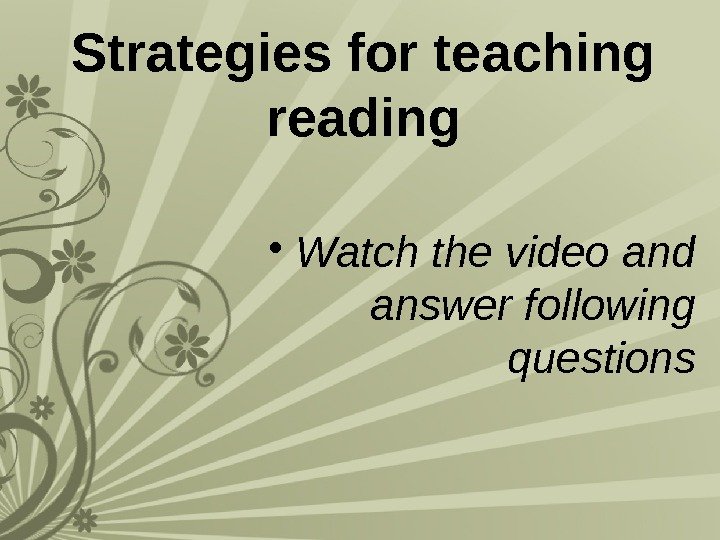
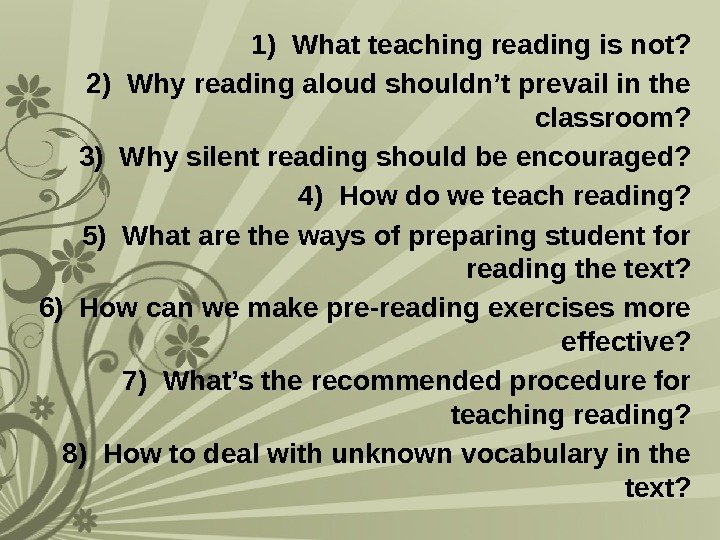

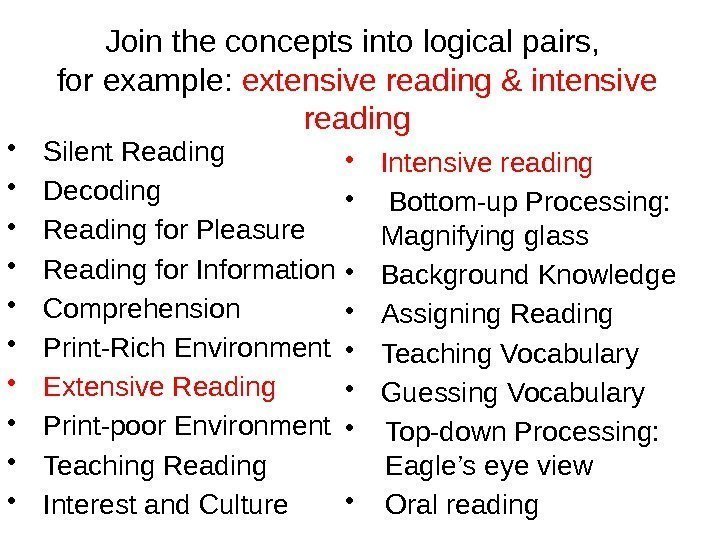
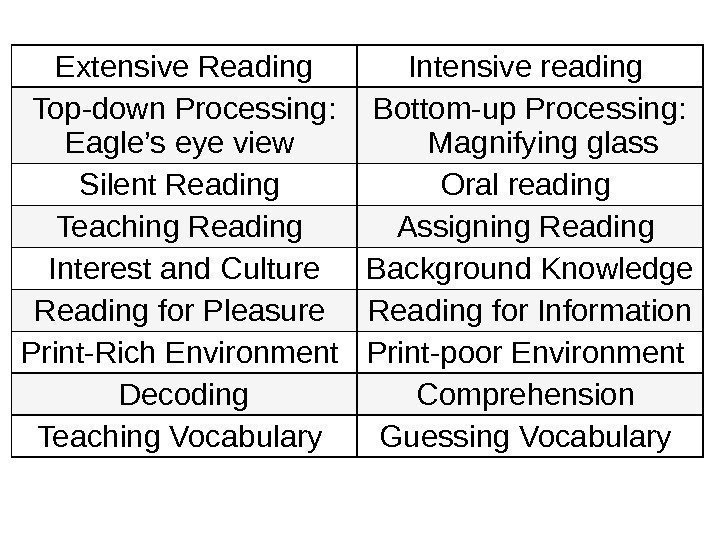


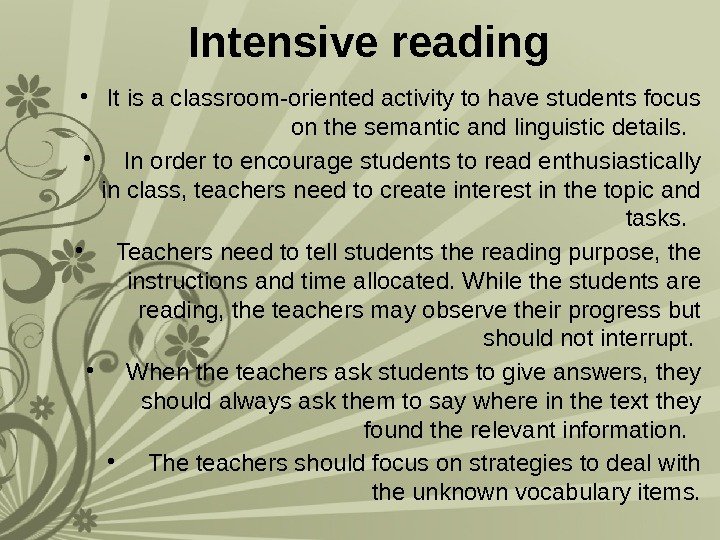
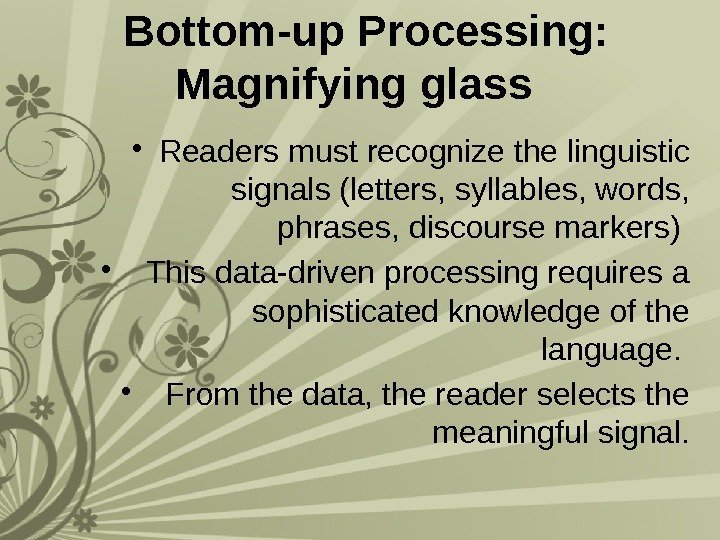
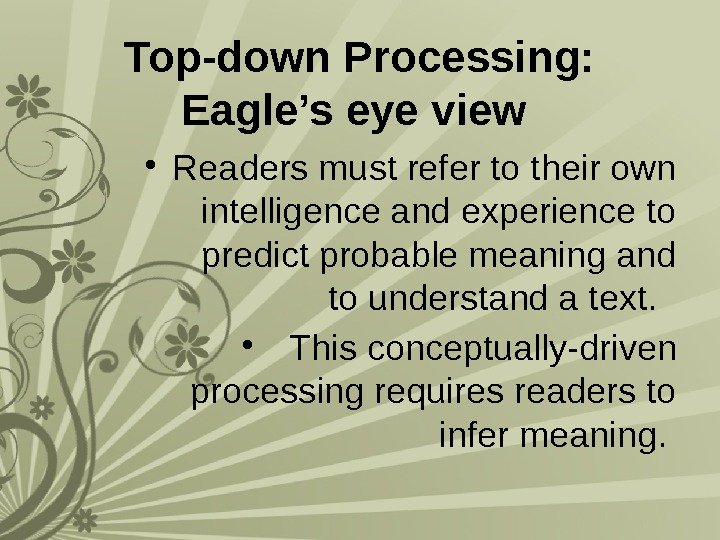
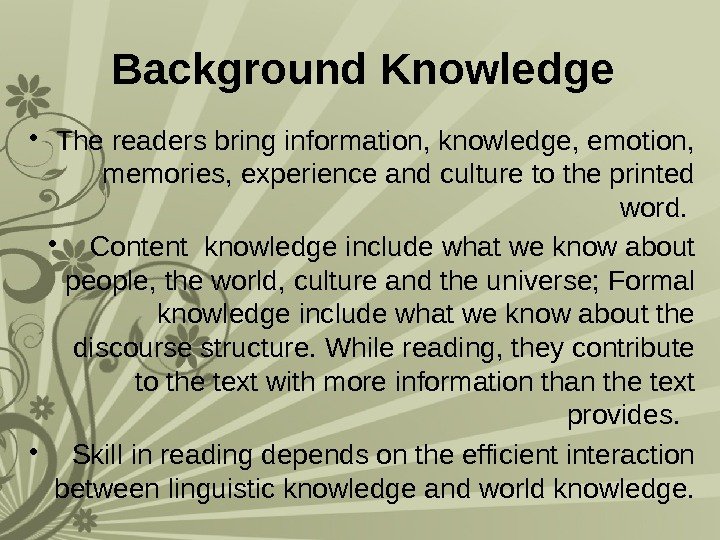
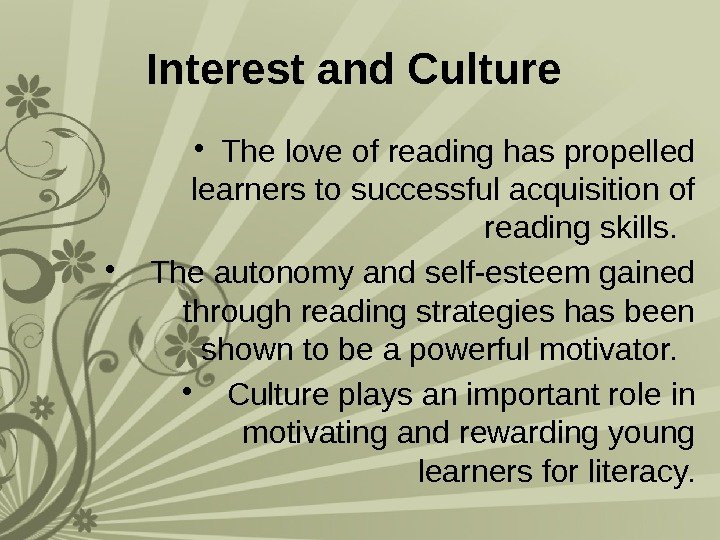
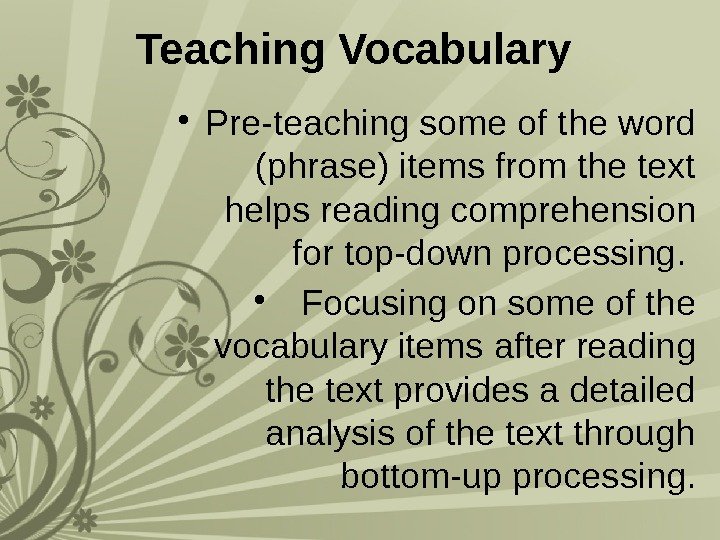
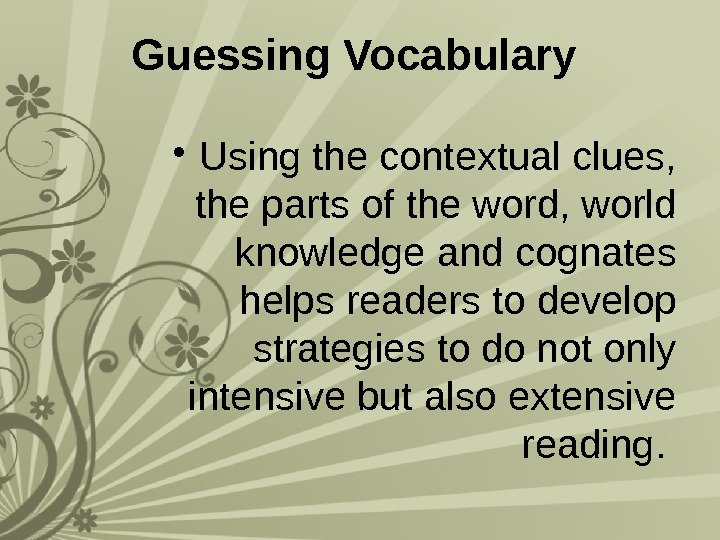
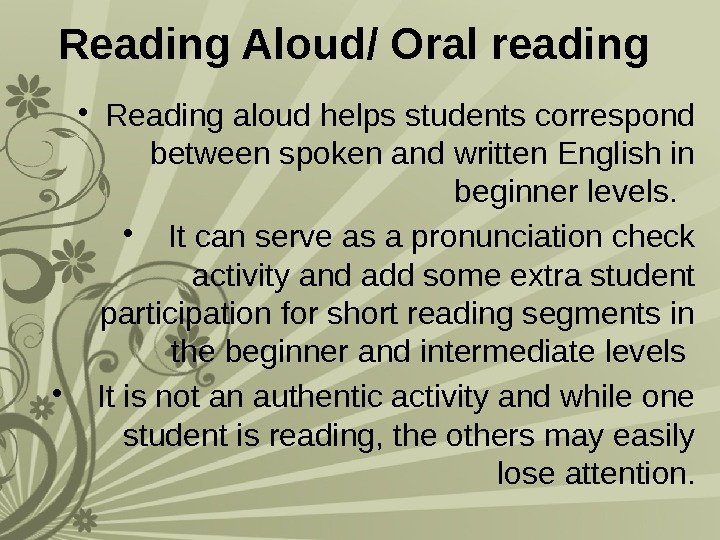
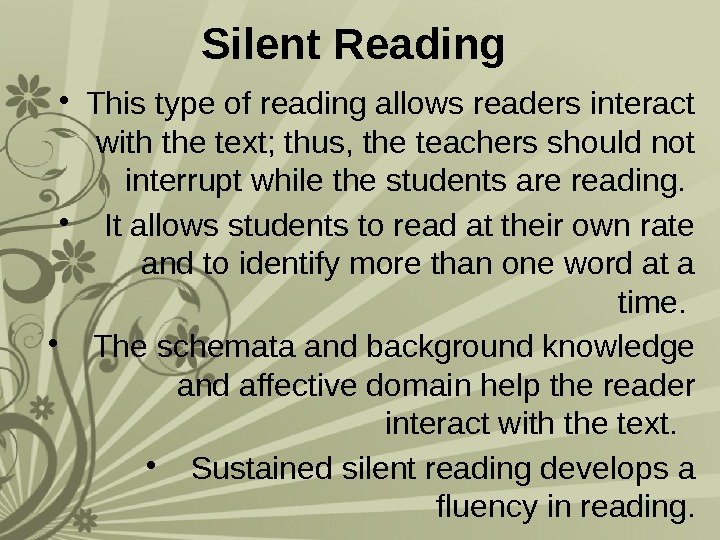
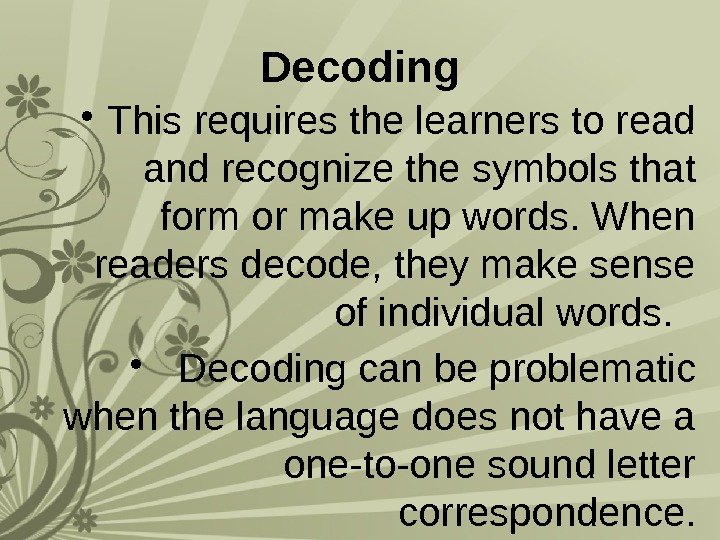

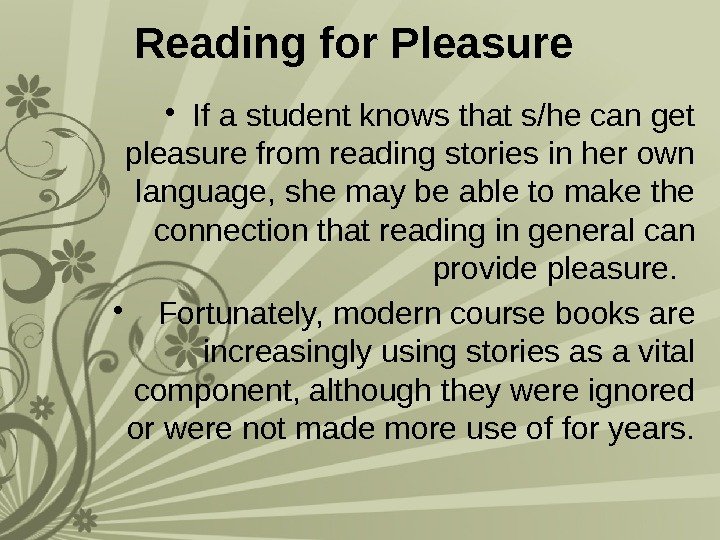
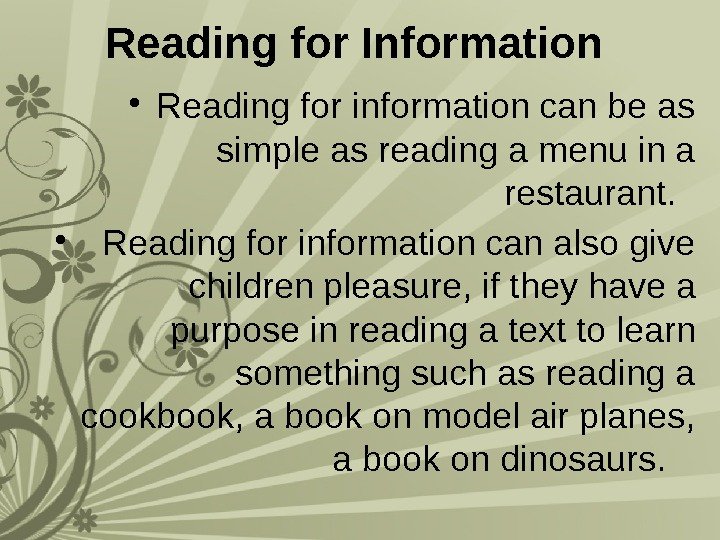

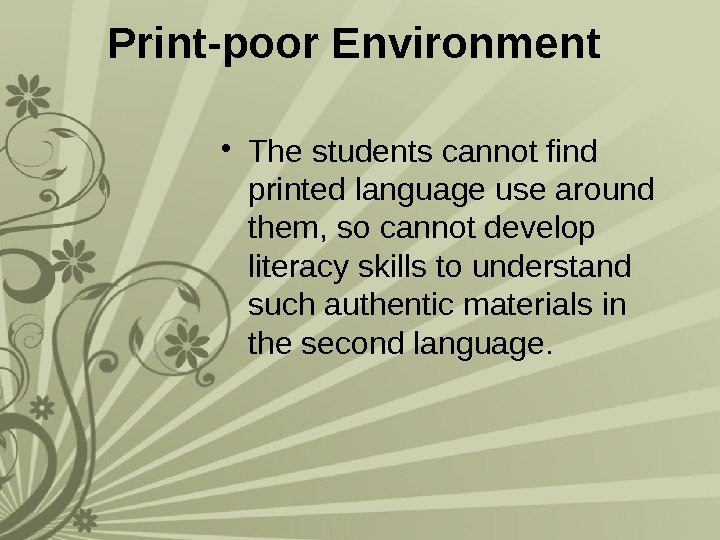
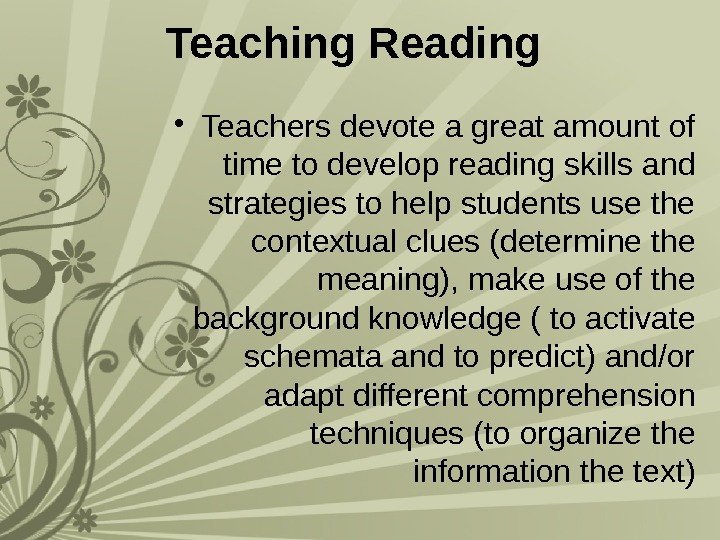
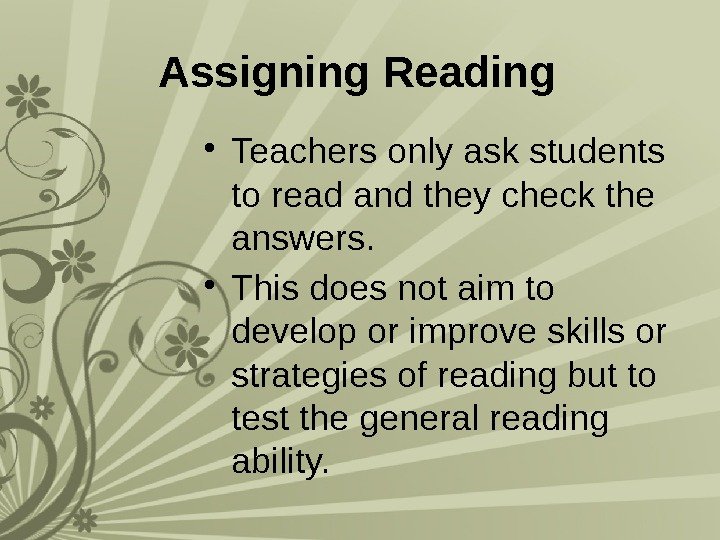
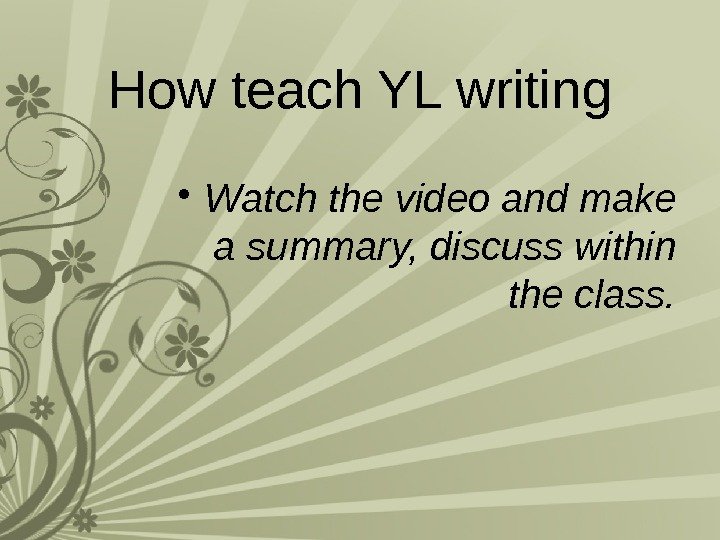
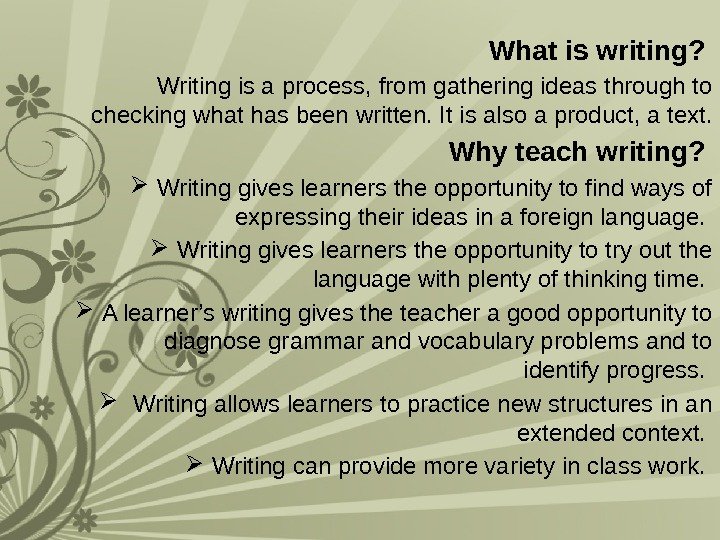

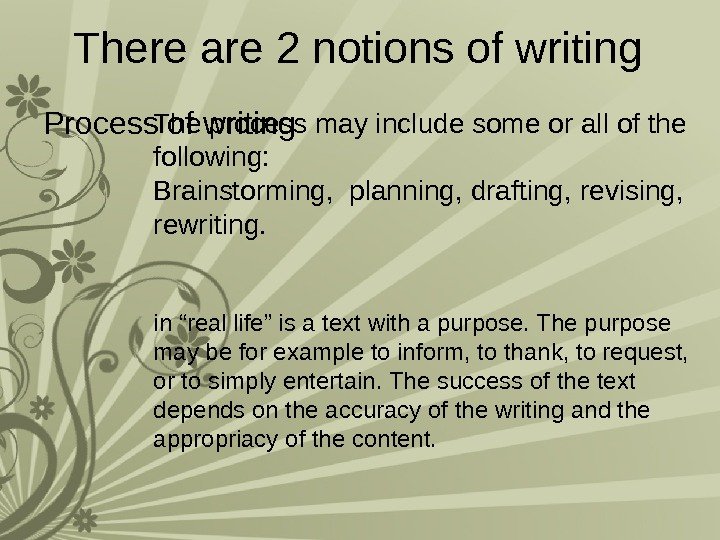
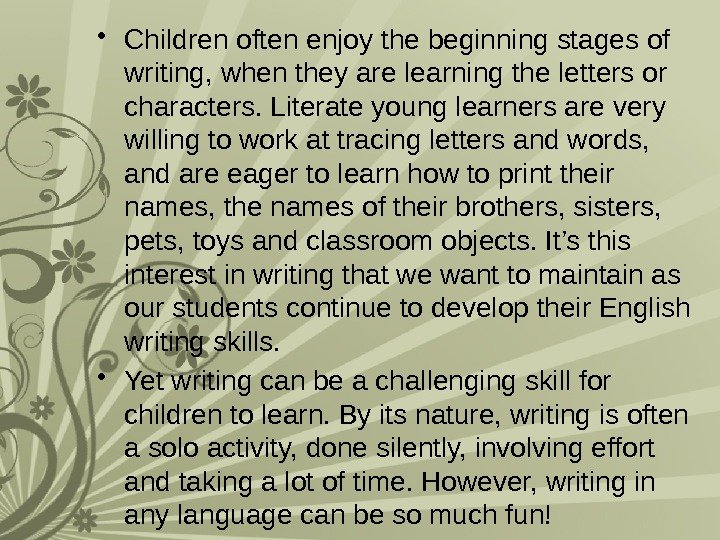
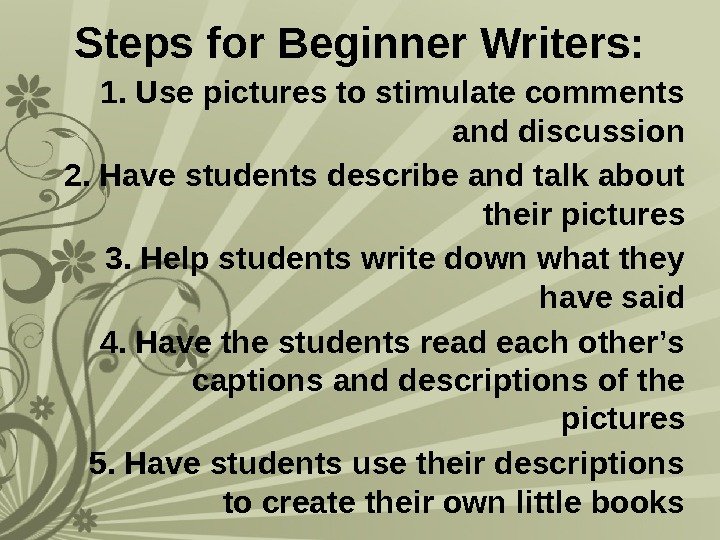
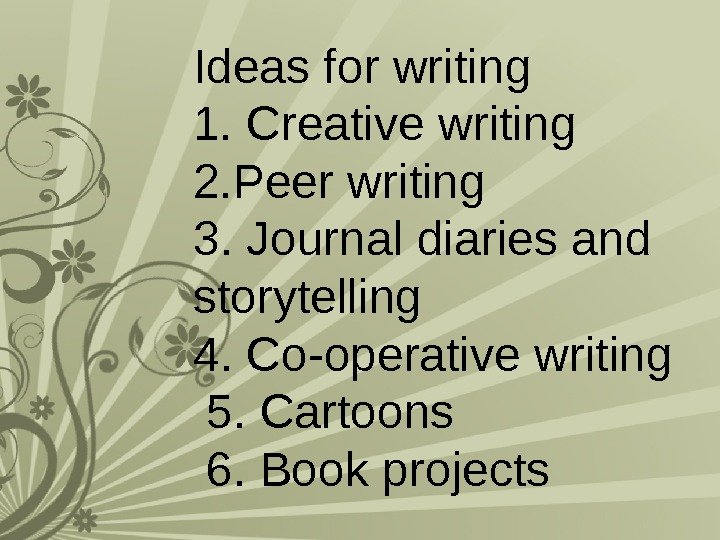
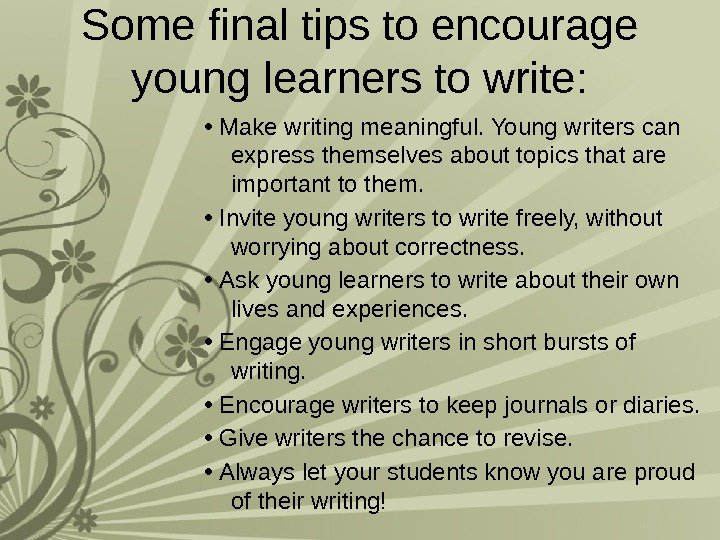
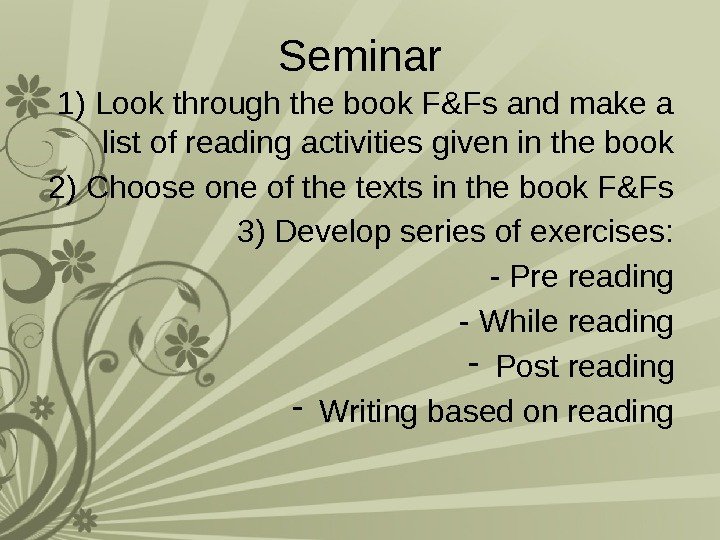
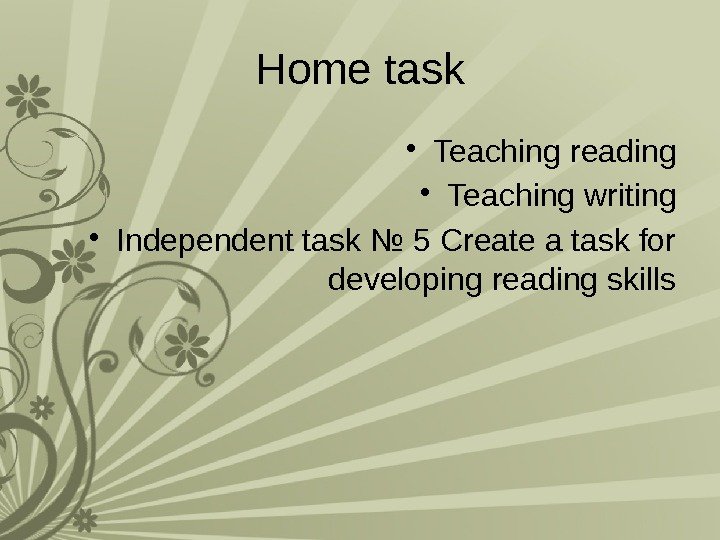
teaching_reading_and_writing.pptx
- Размер: 301.4 Кб
- Автор: Mereke Kaskyrbekkyzy
- Количество слайдов: 35
Описание презентации TEACHING READING AND WRITING Strategies for teaching по слайдам
 TEACHING READING AND WRITING
TEACHING READING AND WRITING
 Strategies for teaching reading • Watch the video and answer following questions
Strategies for teaching reading • Watch the video and answer following questions
 1) What teaching reading is not? 2) Why reading aloud shouldn’t prevail in the classroom? 3) Why silent reading should be encouraged? 4) How do we teach reading? 5) What are the ways of preparing student for reading the text? 6) How can we make pre-reading exercises more effective? 7) What’s the recommended procedure for teaching reading? 8) How to deal with unknown vocabulary in the text?
1) What teaching reading is not? 2) Why reading aloud shouldn’t prevail in the classroom? 3) Why silent reading should be encouraged? 4) How do we teach reading? 5) What are the ways of preparing student for reading the text? 6) How can we make pre-reading exercises more effective? 7) What’s the recommended procedure for teaching reading? 8) How to deal with unknown vocabulary in the text?
 Important Concepts for Teaching Reading and Writing in Young Learner Classes
Important Concepts for Teaching Reading and Writing in Young Learner Classes
 • Intensive reading • Bottom-up Processing: Magnifying glass • Background Knowledge • Assigning Reading • Teaching Vocabulary • Guessing Vocabulary • Top-down Processing: Eagle’s eye view • Oral reading • Silent Reading • Decoding • Reading for Pleasure • Reading for Information • Comprehension • Print-Rich Environment • Extensive Reading • Print-poor Environment • Teaching Reading • Interest and Culture Join the concepts into logical pairs, for example: extensive reading & intensive reading
• Intensive reading • Bottom-up Processing: Magnifying glass • Background Knowledge • Assigning Reading • Teaching Vocabulary • Guessing Vocabulary • Top-down Processing: Eagle’s eye view • Oral reading • Silent Reading • Decoding • Reading for Pleasure • Reading for Information • Comprehension • Print-Rich Environment • Extensive Reading • Print-poor Environment • Teaching Reading • Interest and Culture Join the concepts into logical pairs, for example: extensive reading & intensive reading
 Extensive Reading Intensive reading Top-down Processing: Eagle’s eye view Bottom-up Processing: Magnifying glass Silent Reading Oral reading Teaching Reading Assigning Reading Interest and Culture Background Knowledge Reading for Pleasure Reading for Information Print-Rich Environment Print-poor Environment Decoding Comprehension Teaching Vocabulary Guessing Vocabulary
Extensive Reading Intensive reading Top-down Processing: Eagle’s eye view Bottom-up Processing: Magnifying glass Silent Reading Oral reading Teaching Reading Assigning Reading Interest and Culture Background Knowledge Reading for Pleasure Reading for Information Print-Rich Environment Print-poor Environment Decoding Comprehension Teaching Vocabulary Guessing Vocabulary
 You are going to read article about Concepts for Teaching Reading. Choose the most suitable heading from the list for every paragraph.
You are going to read article about Concepts for Teaching Reading. Choose the most suitable heading from the list for every paragraph.
 Extensive Reading • The teacher encourages the students to choose for themselves what they read for pleasure and general language improvement outside the class. • The students should read materials on the topics they are interested in and materials appropriate for their level. • Original fiction and non-fiction books, simplified works of literature, staged books, magazines can all be used. • In order to encourage reading we can build up a library of suitable books, provide them with extensive reading tasks and encourage them to report back on the reading in different ways.
Extensive Reading • The teacher encourages the students to choose for themselves what they read for pleasure and general language improvement outside the class. • The students should read materials on the topics they are interested in and materials appropriate for their level. • Original fiction and non-fiction books, simplified works of literature, staged books, magazines can all be used. • In order to encourage reading we can build up a library of suitable books, provide them with extensive reading tasks and encourage them to report back on the reading in different ways.
 Intensive reading • It is a classroom-oriented activity to have students focus on the semantic and linguistic details. • In order to encourage students to read enthusiastically in class, teachers need to create interest in the topic and tasks. • Teachers need to tell students the reading purpose, the instructions and time allocated. While the students are reading, the teachers may observe their progress but should not interrupt. • When the teachers ask students to give answers, they should always ask them to say where in the text they found the relevant information. • The teachers should focus on strategies to deal with the unknown vocabulary items.
Intensive reading • It is a classroom-oriented activity to have students focus on the semantic and linguistic details. • In order to encourage students to read enthusiastically in class, teachers need to create interest in the topic and tasks. • Teachers need to tell students the reading purpose, the instructions and time allocated. While the students are reading, the teachers may observe their progress but should not interrupt. • When the teachers ask students to give answers, they should always ask them to say where in the text they found the relevant information. • The teachers should focus on strategies to deal with the unknown vocabulary items.
 Bottom-up Processing: Magnifying glass • Readers must recognize the linguistic signals (letters, syllables, words, phrases, discourse markers) • This data-driven processing requires a sophisticated knowledge of the language. • From the data, the reader selects the meaningful signal.
Bottom-up Processing: Magnifying glass • Readers must recognize the linguistic signals (letters, syllables, words, phrases, discourse markers) • This data-driven processing requires a sophisticated knowledge of the language. • From the data, the reader selects the meaningful signal.
 Top-down Processing: Eagle’s eye view • Readers must refer to their own intelligence and experience to predict probable meaning and to understand a text. • This conceptually-driven processing requires readers to infer meaning.
Top-down Processing: Eagle’s eye view • Readers must refer to their own intelligence and experience to predict probable meaning and to understand a text. • This conceptually-driven processing requires readers to infer meaning.
 Background Knowledge • The readers bring information, knowledge, emotion, memories, experience and culture to the printed word. • Content knowledge include what we know about people, the world, culture and the universe; Formal knowledge include what we know about the discourse structure. While reading, they contribute to the text with more information than the text provides. • Skill in reading depends on the efficient interaction between linguistic knowledge and world knowledge.
Background Knowledge • The readers bring information, knowledge, emotion, memories, experience and culture to the printed word. • Content knowledge include what we know about people, the world, culture and the universe; Formal knowledge include what we know about the discourse structure. While reading, they contribute to the text with more information than the text provides. • Skill in reading depends on the efficient interaction between linguistic knowledge and world knowledge.
 Interest and Culture • The love of reading has propelled learners to successful acquisition of reading skills. • The autonomy and self-esteem gained through reading strategies has been shown to be a powerful motivator. • Culture plays an important role in motivating and rewarding young learners for literacy.
Interest and Culture • The love of reading has propelled learners to successful acquisition of reading skills. • The autonomy and self-esteem gained through reading strategies has been shown to be a powerful motivator. • Culture plays an important role in motivating and rewarding young learners for literacy.
 Teaching Vocabulary • Pre-teaching some of the word (phrase) items from the text helps reading comprehension for top-down processing. • Focusing on some of the vocabulary items after reading the text provides a detailed analysis of the text through bottom-up processing.
Teaching Vocabulary • Pre-teaching some of the word (phrase) items from the text helps reading comprehension for top-down processing. • Focusing on some of the vocabulary items after reading the text provides a detailed analysis of the text through bottom-up processing.
 Guessing Vocabulary • Using the contextual clues, the parts of the word, world knowledge and cognates helps readers to develop strategies to do not only intensive but also extensive reading.
Guessing Vocabulary • Using the contextual clues, the parts of the word, world knowledge and cognates helps readers to develop strategies to do not only intensive but also extensive reading.
 Reading Aloud/ Oral reading • Reading aloud helps students correspond between spoken and written English in beginner levels. • It can serve as a pronunciation check activity and add some extra student participation for short reading segments in the beginner and intermediate levels • It is not an authentic activity and while one student is reading, the others may easily lose attention.
Reading Aloud/ Oral reading • Reading aloud helps students correspond between spoken and written English in beginner levels. • It can serve as a pronunciation check activity and add some extra student participation for short reading segments in the beginner and intermediate levels • It is not an authentic activity and while one student is reading, the others may easily lose attention.
 Silent Reading • This type of reading allows readers interact with the text; thus, the teachers should not interrupt while the students are reading. • It allows students to read at their own rate and to identify more than one word at a time. • The schemata and background knowledge and affective domain help the reader interact with the text. • Sustained silent reading develops a fluency in reading.
Silent Reading • This type of reading allows readers interact with the text; thus, the teachers should not interrupt while the students are reading. • It allows students to read at their own rate and to identify more than one word at a time. • The schemata and background knowledge and affective domain help the reader interact with the text. • Sustained silent reading develops a fluency in reading.
 Decoding • This requires the learners to read and recognize the symbols that form or make up words. When readers decode, they make sense of individual words. • Decoding can be problematic when the language does not have a one-to-one sound letter correspondence.
Decoding • This requires the learners to read and recognize the symbols that form or make up words. When readers decode, they make sense of individual words. • Decoding can be problematic when the language does not have a one-to-one sound letter correspondence.
 Comprehension • Just because a learner knows how to pronounce written words correctly does not mean that he can read. • Reading comprehension refers to reading for meaning and understanding. Thus, it involves higher order thinking skills and more than just decoding words. • Teaching children how to derive meaning as well as analyze and synthesize what they have read is an essential part of the reading process.
Comprehension • Just because a learner knows how to pronounce written words correctly does not mean that he can read. • Reading comprehension refers to reading for meaning and understanding. Thus, it involves higher order thinking skills and more than just decoding words. • Teaching children how to derive meaning as well as analyze and synthesize what they have read is an essential part of the reading process.
 Reading for Pleasure • If a student knows that s/he can get pleasure from reading stories in her own language, she may be able to make the connection that reading in general can provide pleasure. • Fortunately, modern course books are increasingly using stories as a vital component, although they were ignored or were not made more use of for years.
Reading for Pleasure • If a student knows that s/he can get pleasure from reading stories in her own language, she may be able to make the connection that reading in general can provide pleasure. • Fortunately, modern course books are increasingly using stories as a vital component, although they were ignored or were not made more use of for years.
 Reading for Information • Reading for information can be as simple as reading a menu in a restaurant. • Reading for information can also give children pleasure, if they have a purpose in reading a text to learn something such as reading a cookbook, a book on model air planes, a book on dinosaurs.
Reading for Information • Reading for information can be as simple as reading a menu in a restaurant. • Reading for information can also give children pleasure, if they have a purpose in reading a text to learn something such as reading a cookbook, a book on model air planes, a book on dinosaurs.
 Print-Rich Environment • This environment encourage and invite children to develop literacy skills as children realize at an early age that print serves different purposes or functions. • Environmental print is the print all around us such as on signs, labels and billboards, which give authentic reason for reading. • The teachers may prepare such an environment in class through bulletin boards, labels, word lists, posters, calendars, etc.
Print-Rich Environment • This environment encourage and invite children to develop literacy skills as children realize at an early age that print serves different purposes or functions. • Environmental print is the print all around us such as on signs, labels and billboards, which give authentic reason for reading. • The teachers may prepare such an environment in class through bulletin boards, labels, word lists, posters, calendars, etc.
 Print-poor Environment • The students cannot find printed language use around them, so cannot develop literacy skills to understand such authentic materials in the second language.
Print-poor Environment • The students cannot find printed language use around them, so cannot develop literacy skills to understand such authentic materials in the second language.
 Teaching Reading • Teachers devote a great amount of time to develop reading skills and strategies to help students use the contextual clues (determine the meaning), make use of the background knowledge ( to activate schemata and to predict) and/or adapt different comprehension techniques (to organize the information the text)
Teaching Reading • Teachers devote a great amount of time to develop reading skills and strategies to help students use the contextual clues (determine the meaning), make use of the background knowledge ( to activate schemata and to predict) and/or adapt different comprehension techniques (to organize the information the text)
 Assigning Reading • Teachers only ask students to read and they check the answers. • This does not aim to develop or improve skills or strategies of reading but to test the general reading ability.
Assigning Reading • Teachers only ask students to read and they check the answers. • This does not aim to develop or improve skills or strategies of reading but to test the general reading ability.
 How teach YL writing • Watch the video and make a summary, discuss within the class.
How teach YL writing • Watch the video and make a summary, discuss within the class.
 What is writing? Writing is a process, from gathering ideas through to checking what has been written. It is also a product, a text. Why teach writing? Writing gives learners the opportunity to find ways of expressing their ideas in a foreign language. Writing gives learners the opportunity to try out the language with plenty of thinking time. A learner’s writing gives the teacher a good opportunity to diagnose grammar and vocabulary problems and to identify progress. Writing allows learners to practice new structures in an extended context. Writing can provide more variety in class work.
What is writing? Writing is a process, from gathering ideas through to checking what has been written. It is also a product, a text. Why teach writing? Writing gives learners the opportunity to find ways of expressing their ideas in a foreign language. Writing gives learners the opportunity to try out the language with plenty of thinking time. A learner’s writing gives the teacher a good opportunity to diagnose grammar and vocabulary problems and to identify progress. Writing allows learners to practice new structures in an extended context. Writing can provide more variety in class work.
 • Writing, like all other aspects of language, is communicative. • In real life, we may write e-mails, lists, notes, cover letters, reports, curricula, assignments, or essays. Some of us write articles or work on blogs, forums and websites. All of these writing tasks have a communicative purpose and a target audience. • In the English language classroom, writing often lacks that communicative purpose. However, there are ways to make the writing we do with learners more communicative and pleasurable.
• Writing, like all other aspects of language, is communicative. • In real life, we may write e-mails, lists, notes, cover letters, reports, curricula, assignments, or essays. Some of us write articles or work on blogs, forums and websites. All of these writing tasks have a communicative purpose and a target audience. • In the English language classroom, writing often lacks that communicative purpose. However, there are ways to make the writing we do with learners more communicative and pleasurable.
 There are 2 notions of writing Process of writing The process may include some or all of the following: Brainstorming, planning, drafting, revising, rewriting. in “real life” is a text with a purpose. The purpose may be for example to inform, to thank, to request, or to simply entertain. The success of the text depends on the accuracy of the writing and the appropriacy of the content.
There are 2 notions of writing Process of writing The process may include some or all of the following: Brainstorming, planning, drafting, revising, rewriting. in “real life” is a text with a purpose. The purpose may be for example to inform, to thank, to request, or to simply entertain. The success of the text depends on the accuracy of the writing and the appropriacy of the content.
 • Children often enjoy the beginning stages of writing, when they are learning the letters or characters. Literate young learners are very willing to work at tracing letters and words, and are eager to learn how to print their names, the names of their brothers, sisters, pets, toys and classroom objects. It’s this interest in writing that we want to maintain as our students continue to develop their English writing skills. • Yet writing can be a challenging skill for children to learn. By its nature, writing is often a solo activity, done silently, involving effort and taking a lot of time. However, writing in any language can be so much fun!
• Children often enjoy the beginning stages of writing, when they are learning the letters or characters. Literate young learners are very willing to work at tracing letters and words, and are eager to learn how to print their names, the names of their brothers, sisters, pets, toys and classroom objects. It’s this interest in writing that we want to maintain as our students continue to develop their English writing skills. • Yet writing can be a challenging skill for children to learn. By its nature, writing is often a solo activity, done silently, involving effort and taking a lot of time. However, writing in any language can be so much fun!
 Steps for Beginner Writers: 1. Use pictures to stimulate comments and discussion 2. Have students describe and talk about their pictures 3. Help students write down what they have said 4. Have the students read each other’s captions and descriptions of the pictures 5. Have students use their descriptions to create their own little books
Steps for Beginner Writers: 1. Use pictures to stimulate comments and discussion 2. Have students describe and talk about their pictures 3. Help students write down what they have said 4. Have the students read each other’s captions and descriptions of the pictures 5. Have students use their descriptions to create their own little books
 Ideas for writing 1. Creative writing 2. Peer writing 3. Journal diaries and storytelling 4. Co-operative writing 5. Cartoons 6. Book projects
Ideas for writing 1. Creative writing 2. Peer writing 3. Journal diaries and storytelling 4. Co-operative writing 5. Cartoons 6. Book projects
 Some final tips to encourage young learners to write: • Make writing meaningful. Young writers can express themselves about topics that are important to them. • Invite young writers to write freely, without worrying about correctness. • Ask young learners to write about their own lives and experiences. • Engage young writers in short bursts of writing. • Encourage writers to keep journals or diaries. • Give writers the chance to revise. • Always let your students know you are proud of their writing!
Some final tips to encourage young learners to write: • Make writing meaningful. Young writers can express themselves about topics that are important to them. • Invite young writers to write freely, without worrying about correctness. • Ask young learners to write about their own lives and experiences. • Engage young writers in short bursts of writing. • Encourage writers to keep journals or diaries. • Give writers the chance to revise. • Always let your students know you are proud of their writing!
 Seminar 1) Look through the book F&Fs and make a list of reading activities given in the book 2) Choose one of the texts in the book F&Fs 3) Develop series of exercises: — Pre reading — While reading — Post reading — Writing based on reading
Seminar 1) Look through the book F&Fs and make a list of reading activities given in the book 2) Choose one of the texts in the book F&Fs 3) Develop series of exercises: — Pre reading — While reading — Post reading — Writing based on reading
 Home task • Teaching reading • Teaching writing • Independent task № 5 Create a task for developing reading skills
Home task • Teaching reading • Teaching writing • Independent task № 5 Create a task for developing reading skills

